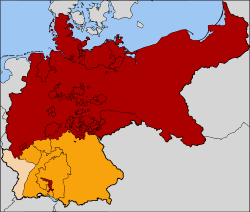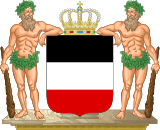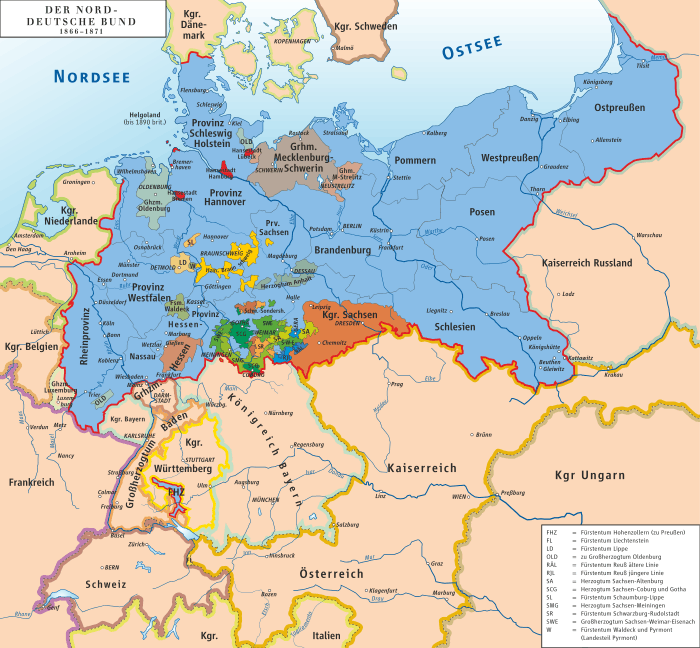North German Confederation
The North German Confederation (German: Norddeutscher Bund)[1] was the German federal state which existed from July 1867 to December 1870. Although de jure a confederacy of equal states, the Confederation was de facto controlled and led by the largest and most powerful member, Prussia, which exercised its influence to bring about the formation of the German Empire. Some historians also use the name for the alliance of 22 German states formed on 18 August 1866 (Augustbündnis). In 1870–1871, the south German states of Baden, Hesse-Darmstadt, Württemberg and Bavaria joined the country. On 1 January 1871, the country adopted a new constitution, which was written under the title of a new "German Confederation" but already gave it the name "German Empire" in the preamble and article 11.
North German Confederation Norddeutscher Bund | |||||||||||||||
|---|---|---|---|---|---|---|---|---|---|---|---|---|---|---|---|
| 1867–1871 | |||||||||||||||
 The North German Confederation in 1867 | |||||||||||||||
 The North German Confederation (red). The southern German states that joined in 1870 to form the German Empire are in orange. Alsace-Lorraine, the territory annexed following the Franco-Prussian War of 1870, is in tan. The red territory in the South marks the original princedom of the House of Hohenzollern, rulers of the Kingdom of Prussia. | |||||||||||||||
| Status | Federal state | ||||||||||||||
| Capital | Berlin | ||||||||||||||
| Common languages | German, Danish, Low German, East Frisian, North Frisian, Czech, Lithuanian, Polish, Sorbian, Yiddish | ||||||||||||||
| Religion | Majority: Protestant (Lutheran, Reformed, United) Minorities:
Roman Catholic, Jewish | ||||||||||||||
| Government | Confederal constitutional monarchy | ||||||||||||||
| President | |||||||||||||||
• 1867–1871 | Wilhelm I | ||||||||||||||
| Chancellor | |||||||||||||||
• 1867–1871 | Otto von Bismarck | ||||||||||||||
| Legislature | Reichstag | ||||||||||||||
• Federal Council | Bundesrat | ||||||||||||||
| Historical era | New Imperialism | ||||||||||||||
| 18 August 1866 | |||||||||||||||
| 16 April 1867 | |||||||||||||||
| 19 July 1870 | |||||||||||||||
| 18 January 1871 | |||||||||||||||
| Currency | Vereinsthaler | ||||||||||||||
| |||||||||||||||
| Today part of | |||||||||||||||
The federal constitution established a constitutional monarchy with the Prussian king as the bearer of the Bundespräsidium, or head of state. Laws could only be enabled with the consent of the Reichstag (a parliament based on universal male suffrage) and the Federal Council (a representation of the states). During the four years of the North German Confederation, a conservative-liberal cooperation undertook important steps to unify (Northern) Germany with regard to law and infrastructure. The political system (and the political parties) remained essentially the same in the years after 1870.
The North German Confederation had nearly 30 million inhabitants, of whom eighty percent lived in Prussia.
Creation of the North German Confederation
Prussia's plans to unify Germany
For the most of 1815–1848, Austria and Prussia worked together and used the German Confederation as a tool to suppress liberal and national ambitions in the German population. In 1849, the National Assembly in Frankfurt elected the Prussian king as the Emperor of a Lesser Germany (a Germany without Austria). The king refused and tried to unite Germany with the Erfurt Union of 1849–1850. When the union parliament met in early 1850 to discuss the constitution, the participating states were mainly only those in Northern and Central Germany. Austria and the southern German states Württemberg and Bavaria forced Prussia to give up its union plans in late 1850.[2]
In April and June 1866, Prussia proposed a Lesser Germany again. Corner stone of the proposal was the election of a German parliament based on universal male suffrage.[3] The proposal even explicitly mentioned the Frankfurt election law of 1849. Otto von Bismarck, the minister-president of Prussia, wanted to gain sympathy within the national and liberal movement of the time. Austria and its allies refused the proposal. In summer 1866 Austria and Prussia fought with their respective allies in the Austro-Prussian War.
Aftermath of the 1866 war
Prussia and Austria signed a Nikolsburg preliminary (26 July) and a final peace treaty of Prague (23 August). Austria affirmed the Prussian view that the German Confederation was dissolved. Prussia was allowed to create a "closer federation" (einen engeren Bund) in Germany north of the river Main. Bismarck had already agreed on this limitation with the French emperor Napoleon III prior to the peace talks.[4]
The liberals in the Prussian parliament favored a wholesale annexation of all North German territories by Prussia. In a similar way, Sardinia–Piemont had created the kingdom of Italy. But Bismarck chose a different approach. Prussia incorporated (in October 1866) only the former military opponents Hannover, Hesse-Kassel, Nassau, the free city of Frankfurt and the Hesse-Homburg area of Hesse Darmstadt. These areas were combined into the two new Prussian provinces of Hannover and Hesse-Nassau. Schleswig and Holstein also became a Prussian province.[5]
On 18 August 1866, Prussia and a larger number of North and Central German states signed a Bündniß (alliance). The treaty created a military alliance for one year. It also affirmed that the states wanted to form a federal state based on the Prussian proposals of June 1866. They agreed to have a parliament elected to discuss a draft constitution. Later in 1866, other states joined the treaty. Saxony and Hesse-Darmstadt, former enemies in the war of 1866, had to agree their accession to the new federation in their respective peace treaties (Hesse-Darmstadt only joined with its northern province, Upper Hesse).[6]
Towards a federal constitution
Bismarck sought advice from conservative and democratic politicians and finally presented a draft constitution to the other state governments. It was his intention to make the new federal state look like a confederation in the tradition of the German Confederation. This explains the name of the country and several provisions in the draft constitution. Bismarck wanted to make the federal state more attractive (or less repulsive) to southern German states which might later join.[7]
At the same time, in late 1866, Prussia and the other states prepared the election of a North German parliament. This konstituierender Reichstag was elected in February 1867 based on state laws. The konstituierender Reichstag gathered from February to April. In close talks with Bismarck it altered the draft constitution in some significant points. The konstituierender Reichstag was not a parliament but only an organ to discuss and accept the draft constitution. After that, the state parliaments (June 1867) ratified it so that on 1 July the constitution was enabled. In August, the first Reichstag of the new federal state was elected.
Four years of legislation
During the roughly four years of the North German Confederation its major action existed in legislation unifying Northern Germany. The Reichstag decided on laws concerning, for example:
- free movement of citizens within the territory of the Confederation (1867)
- a common postal system (1867–1868)
- common passports (1867)
- equal rights for the different religious denominations (1869)
- unified measures and weights (with the obligatory introduction of the metric system)
- penal code (1870)
The North German Confederation also became a member of the Zollverein, the German customs union of 1834.
Political system

The North German Constitution of 16 April 1867 created a national parliament with universal suffrage (for men above the age of 25), the Reichstag. Another important organ was the Bundesrat, the 'federal council' of the representatives of the allied governments. To adopt a law, a majority in the Reichstag and in the Bundesrat was necessary. This gave the allied governments, meaning the states and their princes, an important veto.
Executive power was vested in a president, a hereditary office of the House of Hohenzollern, the ruling family of Prussia. He was assisted by a chancellor responsible only to him – an office that Bismarck designed with himself in mind. There was no formal cabinet; the heads of the departments were not called ministers but secretaries. Those were installed and dismissed by the chancellor.
For all intents and purposes, the confederation was dominated by Prussia. It had four-fifths of the confederation's territory and population – more than the other 21 members combined. The presidency was a hereditary office of the Prussian crown. Bismarck was also foreign minister of Prussia, a post he held for virtually his entire career. In that role he instructed the Prussian deputies to the Bundesrat. Prussia had 17 of 43 votes in the Bundesrat despite being by far the largest state, but could easily get a majority by making alliances with the smaller states.
Customs Union
In June 1867 a conference took place between Prussia and the south German states, who were not members of the North German Confederation. After pressure from Prussia, new Customs Union (Zollverein) treaties were signed the following month. Henceforth, the governing bodies of the Customs Union were the Bundesrat and Reichstag of the North German Confederation, augmented by representatives of the south German governments in the former and members from these states elected in the same way as the others in the latter. When augmented thus for customs matters, the institutions were known as the Federal Customs Council and the Customs Parliament (Zollparlament).[8] On 1 January 1868 the new institutions came into force. Bismarck hoped that the Zollverein might become the vehicle of German unification. But in the 1868 Zollparlament election the South Germans voted mainly for anti-Prussian parties.
On the other hand, the two Mecklenburg duchies and three Hanseatic cities were initially not members of the Customs Union. The Mecklenburgs and Lubeck joined soon after the North German Confederation was formed. Eventually, after heavy Prussian pressure, Hamburg acceded to the Customs Union in 1888. Bremen joined at the same time. Despite this, all these states fully participated in the federal institutions, even while outside the Customs Union and not directly affected by their decisions in that regard.
Transition to the German Empire (1870–71)
In mid-1870, a diplomatic crisis concerning the Spanish throne led eventually to the Franco-Prussian War.[9] During the war, in November 1870, the North German Confederation and the south German states of Bavaria, Württemberg, and Baden (together with the parts of Hesse-Darmstadt which had not originally joined the confederation) united to form a new nation state. It was originally called Deutscher Bund (German Confederation), but on 10 December 1870 the Reichstag of the North German Confederation adopted the name Deutsches Reich (German Realm or German Empire) and granted the title of German Emperor to the King of Prussia as Bundespräsidium of the Confederation.[10] On 1 January 1871 the new constitution gave the country the name 'German Empire' and the title of Emperor to King William. He accepted the title on 18 January 1871. This latter date was later regarded as the creation of the Empire, although it had no constitutional meaning.
A new Reichstag was elected on 3 March 1871. The constitutions of 1 January and 16 April 1871 constitution of the Empire were nearly identical to that of the North German Confederation, and the Empire adopted the North German Confederation's flag.

Postage stamps
One of the functions of the confederation was to handle mail and issue postage stamps.
List of member states
| State | Capital | |
|---|---|---|
| Kingdoms (Königreiche) | ||
| Prussia (Preußen) (including Lauenburg) |
Berlin | |
| Saxony (Sachsen) | Dresden | |
| Grand Duchies (Großherzogtümer) | ||
| Hesse (Hessen) (Only Upper Hesse, the province north of the River Main) |
Giessen | |
| Mecklenburg-Schwerin | Schwerin | |
| Mecklenburg-Strelitz | Neustrelitz | |
| Oldenburg | Oldenburg | |
| Saxe-Weimar-Eisenach (Sachsen-Weimar-Eisenach) | Weimar | |
| Duchies (Herzogtümer) | ||
| Anhalt | Dessau | |
| Brunswick (Braunschweig) | Braunschweig | |
| Saxe-Altenburg (Sachsen-Altenburg) | Altenburg | |
| Saxe-Coburg and Gotha (Sachsen-Coburg und Gotha) | Coburg | |
| Saxe-Meiningen (Sachsen-Meiningen) | Meiningen | |
| Principalities (Fürstentümer) | ||
| Lippe | Detmold | |
| Reuss-Gera (Junior Line) | Gera | |
| Reuss-Greiz (Elder Line) | Greiz | |
| Schaumburg-Lippe | Bückeburg | |
| Schwarzburg-Rudolstadt | Rudolstadt | |
| Schwarzburg-Sondershausen | Sondershausen | |
| Waldeck and Pyrmont (Waldeck und Pyrmont) | Arolsen | |
| Free and Hanseatic Cities (Freie und Hansestädte) | ||
| Bremen | ||
| Hamburg | ||
| Lübeck | ||
See also
- North German Constitution
- Former countries in Europe after 1815
- German unification
References
- An alternative translation is "North German Federation."
- David E. Barclay: Preußen und die Unionspolitik 1849/1850. In: Gunther Mai (ed.): Die Erfurter Union und das Erfurter Unionsparlament 1850. 2000, pp. 53–80, here pp. 78–80.
- Ernst Rudolf Huber: Deutsche Verfassungsgeschichte seit 1789. Vol. III: Bismarck und das Reich. 3rd edition, Kohlhammer Verlag, Stuttgart et al. 1988, pp. 536/537.
- Ernst Rudolf Huber: Deutsche Verfassungsgeschichte seit 1789. Vol. III: Bismarck und das Reich. W. Kohlhammer, Stuttgart [et al.] 1963, p. 570.
- Ernst Rudolf Huber: Deutsche Verfassungsgeschichte seit 1789. Vol. III: "Bismarck und das Reich". 3rd edition, W. Kohlhammer, Stuttgart (et al.) 1988, pp. 580–583.
- Michael Kotulla: Deutsche Verfassungsgeschichte. Vom Alten Reich bis Weimar (1495–1934). Springer, Berlin 2008, pp. 491–492.
- Christoph Vondenhoff: Hegemonie und Gleichgewicht im Bundesstaat. Preußen 1867–1933: Geschichte eines hegemonialen Gliedstaates. Diss. Bonn 2000, Shaker Verlag, Aachen 2001, pp. 31–33.
- Henderson, William. The Zollverein. Publ Cambridge University Press, 1939; p.314
- Görtemaker, Manfred (1983). Deutschland im 19. Jahrhundert: Entwicklungslinien. Opladen. p. 244.
- Case, Nelson (1902). European Constitutional History. Cincinnati: Jennings & Pye. pp. 139–140. OCLC 608806061.CS1 maint: ref=harv (link)
Further reading
![]()
- Craig, Gordon A. Germany, 1866–1945 (1978) pp. 11–22 online edition
- Holborn, Hajo. A History of Modern Germany: 1840–1945 (1969) pp. 173–232
- Hudson, Richard. "The Formation of the North German Confederation." Political Science Quarterly (1891) 6#3 pp: 424-438. in JSTOR
- Nipperdey, Thomas. Germany from Napoleon to Bismarck: 1800-1866 (1996), very dense coverage of every aspect of German society, economy and government
- Pflanze, Otto. Bismarck and the Development of Germany, Vol. 1: The Period of Unification, 1815–1871 (1971)
- Taylor, A.J.P. Bismarck: The Man and the Statesman (1967) online edition
.svg.png)

